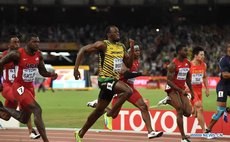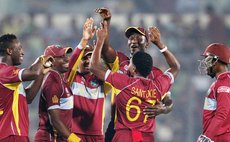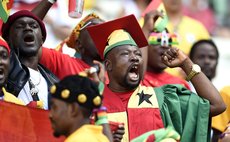Money, money, money
A speculative look at West Indies Cricket
Thirty-six years ago in 1978, the first major crisis of a financial nature arose in West Indies cricket. Previously whatever problems occurring had to do with doubtful umpiring decisions sparking bottle throwing onto the field of play or extreme ire over a controversial incident or crowd boycott over non-inclusion of a particular player in the Test team. Also, there had been political intervention to ban certain foreign players from visiting one or other territories on account of their having played in South Africa while its apartheid regime was in power. What occurred in 1978 was inspired by differences between star players and the West Indies Cricket Board – the former agreeing to throw in their lot with an intrusive organization seeking to revolutionize international cricket, all in contravention to positions long held by the board and parallel with other similar administrative establishments overseas.
All this led to a mild disruption of the Australia tour to the Caribbean in 1977/78. I say mild because the tour continued after the West Indies board proceeded to ban Clive Lloyd, Gordon Greenidge, Desmond Haynes, Vivian Richards, Richard Austin, Deryck Murray, Andy Roberts, Colin Croft and Joel Garner after the nine had contracted to participate in a World Series Cricket engagement organized by newspaper and television magnate Kerry Packer of Australia.
Lloyd and his men had won the first two Tests against Australia. However, the board drafted a new team for the remaining Tests. Lloyd was replaced as captain by Alvin Kallicharran. The other player retained from the winning team was spinner Derick Parry who with Alvin Greenidge, Larry Gomes, Basil Williams, Irving Shillingford, David Murray, Sew Shivnarine, Norbert Phillip, Vanburn Holder, and Sylvester Clarke helped complete the new look side for the third Test at Guyana on 31st March, 1978, against Australia.
The possibility of doing this was facilitated by what may be considered a solid base of players suitable for replacement purposes. In the batting Gomes scored 265 (average 44.46), Williams 257 (av. 42.83), Alvin Greenidge 142 (average 35.50), Phillip 120 (av. 24.00) to complement Kallicharran's 405 (av. 51.00) and Parry's 193 (av. 27.57), the last two having played in all five of the Tests. The makeshift side won one, lost one and drew the other of the three Tests completing the series against Australia.
Pursuant to this the West Indies board retained Kallicharran for the ensuing tour to India some months later. For the first Test at Bombay Alvin Greenidge and Basil Williams opened the batting followed by Gomes, Kallicharran, Faoud Bacchus, David Murray, Parry, Phillip, Holder, Rapheek Jumadeen and Clarke.
For the record, India won one Test and the remaining five were drawn. Williams chalked up 212 runs for an average of 35.33, Gomes 405 (av. 40.50) Kallicharran 438 (av. 59.77) Bacchus 472 (av. 47.20) David Murray 261 (av. 29.00), Parry 170 (av. 24.25) and Phillip 177 (av. 35.40). Notable in the bowling Clarke took 21 wickets (av. 33.85) and Phillip 19 (av. 34.21).
That, though, was the end of the somewhat disturbing episode in West Indies cricket. The Kerry Packer issue was soon resolved and the big guns returned to their positions in the regional team to continue an extended dominance by West Indies in world cricket, making Lloyd the most successful Test captain and Richards, his successor, the only captain never to have lost a Test series.
Current disruption of West Indies cricket places on centre stage a dispute between players and their representative association on pay issues. To be borne in mind is an agreement the board entered into with the India authorities which would have seen $35,000 (U.S) payable to the players collectively for each playing day of the cancelled tour. The average income per player would be $49,000 (U.S) from the expected payout package of $735,000 (U.S) for the three Tests, five one day internationals and one T20 match. To all intents and purposes, quite a tidy sum.
The computations given are approximate. But it is to be assumed that projections for the players expected pay, on the premise that they could have three such tours in a year, would equate at an average of $147,000 (U.S) per player. This is of the order of around $391,000 to $400,000 (E.C). The man in the street computes this as $36,000 per month – more than what most ordinary people receive in a full year, if they can secure employment of a continuous sort!
Of course, none of this includes other remuneration likely to accrue to the players for their services for playing in the Indian Premier League, the Australian Big Bash, the Bangladesh League, the Caribbean League etc, etc.
Big money continues to be spun, on and on ceaselessly. India is the place with the biggest crowds by far. However, where the crowds are relatively absent, the revenue shortfall is more than amply made up via television and sponsorship rights.
Almost unanimously the Caribbean public concurs that the West Indian players should have carried on with the Indian tour and left any grievances for ventilation at an appropriate time. Maybe, the players thought their action to discontinue the tour was opportune. How really?
The board is expected to send a team to South Africa next month. This is on the eve, so to speak, of the World Cup carded for early in the New Year. India was looking at their engagements with West Indies as suitable rehearsal for the World Cup. By the same token, West Indies ought to have been seeking to dust and polish its preparations for the World Cup and arrive at desired fine tuning in South Africa. As it is now, a strong element of uncertainty has descended upon the state of affairs surrounding West Indies cricket. India has shuffled to bring in Sri Lanka to replace West Indies for the remainder of the cancelled tour schedule. Will South Africa see their forthcoming engagement with West Indies as fraught with grave risk and potential disaster? Will a number of countries think the best way to insure against such risk is to place tours to and from the West Indies in abeyance, at least for the foreseeable future?
Anyone's guess is as good as any other. India is seeking damages of around $46 million (U.S) and the West Indies board is squirming in its sorry predicament, having met with a no thank you to its offer to India of a replacement team to continue the torpedoed tour.
When the calamity of 1978 took place West Indies were the top team in the world and could flex its muscle to call some of the shots on the international stage. Right now its premier team does not carry much clout, making us beggars in the world of the affluent. Many are saying: "In for a penny, in for a pound," the players en bloc should be discarded! We lose, any way we manoeuvre, with or without the "better players".
How much do we peer into the dark for the silver lining behind the dark cloud? Let's say an opportunity arrives for the board to enter into creditable arrangements with the players – allowing the way forward for measures of performance rating to be a determinant in the payment of players. This has been long overdue and it is unfortunate such leaning to the positive did not materialize when the West Indies were on top of world cricket. At least it could have been a tasty and sensible carrot to dangle before the then avid group of solid professionals who were nowhere as well paid as the present day pretenders. The resolve of all concerned might have sharpened appreciably with impressive effect. The Windward Islands, long the poor relations of West Indies Cricket, should be actively positioning to take advantage of current upheavals, whatever their portents.




